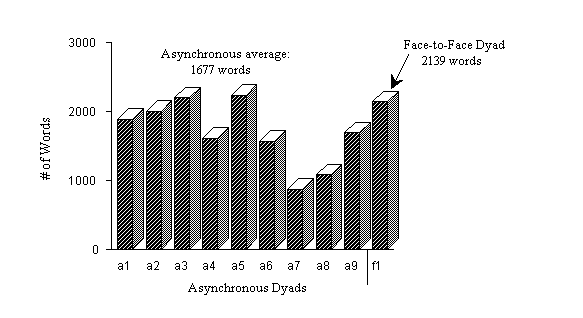

In the planning and proposal stages of this research, there was very real concern about the quantity and quality of the typed verbal exchanges that would transpire. Although the subjects had experience working on a similar task in small groups, and although they may have used typewriters or wordprocessors to express and communicate their thoughts, it was not clear whether they would be able to engage in productive interactive discussions using text-based computer-mediated communication.
Nevertheless, past experience with online communication, and evidence from the pilot study, indicated that appropriate interaction would occur. Also the instructions given to the subjects emphasized the objective of communicating and discussing the case with their partners in order to mutually determine nursing diagnosis and related nursing care planning (ND/NCP).
The very first subject, however, seemed to forebode the worst. In asynchronous mode, the nursing student addressed the task directly as if answering an exam question. The existence of a partner was not acknowledged explicitly or implicitly. There were no questions or requests for confirmation, and there were no statements suggesting a coordinated effort toward resolution of the problem. Rather, the very blunt first note was:
Depression related to poor self-esteem. Support from friends will be important. Feelings of helplessness and anxiety are important.And the second note from this subject was:
This client's situation needs to be dealt with immediately. Although he says he would not harm himself, he may if counseling is not given. Client requires professional support as well as support from family and friends.
Fortunately, the partner in this dyad had a better idea of the interactive orientation suggested in the instructions. The first response was:
I agree on your first diagnosis: depression related
to poor self-esteem. As a second diagnosis, I suggest:
alterations in coping abilities; anxiety and panic related
to feelings of helplessness. This would incorporate your
ideas that helplessness and anxiety of the client are
important aspects of this case. What do you think?
It was not that the first nursing diagnosis they discuss is correct (since depression is a medical diagnosis, not a nursing diagnosis), it was the acknowledgement of the partner and the subsequent effort to integrate the ideas of one's partner with one's own developing thoughts that demonstrated, at this early point in the data collection phase, that the types of verbal exchanges expected would in fact appear in the transcripts. Most of the remaining dyads began their discussions with much greater attention to the interactive potential.
Another concern about the dyad activity was related to the overall amount of time allowed for completion of the task. As noted in section @Ref(secproced) both groups were given a two-hour period in total. Asynchronous dyad members alternated four half-hour sessions each, and the synchronous dyad members attended together for one two-hour session.
The quantity of this text-based verbal exchange was measured by counting words. As Figures @Ref(fwdcnt1a) and @Ref(fwdcnt1s) show, the number of words was slightly greater for the asynchronous dyads than the synchronous dyads. The transcripts and comments from members of both groups, however, indicate that the nursing diagnosis and nursing care planning task as a whole was completed and most participants felt the allotted time was sufficient.
Figure 4-1: Asynchronous Word Count

Figure 4-2: Synchronous Word Count
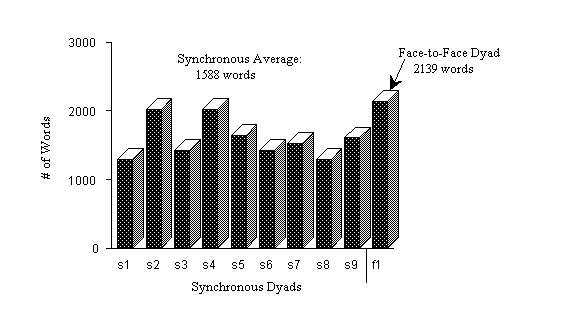
In fact, all matters relating to the preparation and provision of an adequate environment for the conduct of observable educational events (nursing student dyads discussing a nursing case) proved quite successful. The number of participants, the basic homogeneity of their ability and experience, the quantity of verbal exchanges, and the nature of their interactions in terms of cognitive and cooperative activity; all were deemed sufficient for the purposes of this research.
The 38 nursing students who participated in this study constitute a self-selected, convenience sample. They were randomly assigned to the two main comparison groups (9 dyads used synchronous mode and 9 dyads used asynchronous mode). Two subjects were assigned to the face-to-face mode in order to demonstrate how the same content and problem might be handled in a more conventional dyad discussion. The data and information derived from the face-to-face dyad were used to help the researcher gain a broader understanding of the characteristics of interaction; they were not sufficient for full qualitative analysis and comparison in this study.
The two main groups were quite homogeneous on factors such as age, sex, education, marks, and previous related experience. The distribution and variation in age and sex are shown in Figures @Ref(fage1) and @Ref(fsex1) respectively.
Figure 4-3: Age Distribution
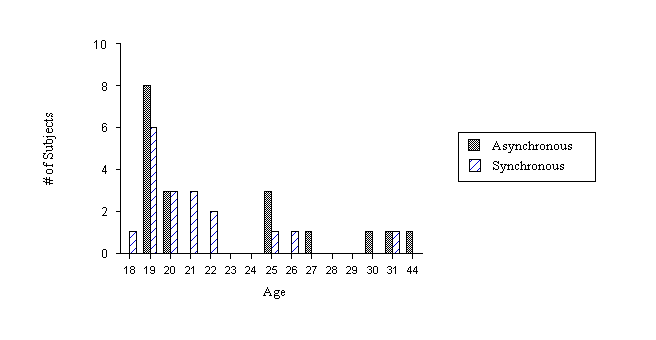
Figure 4-4: Sex Distribution
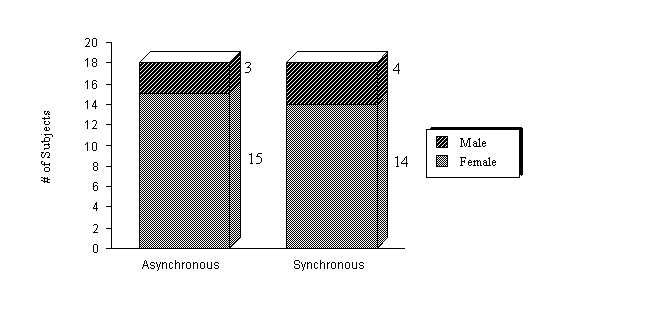
Table @Ref(tabedyrmrk) shows the highest level of education attained by the subjects before entering the nursing program, the year of the nursing program they were in at the time of this study, and their relative marks (self reported).
The importance of computers in their previous education of the asynchronous group was rated as "not at all" by 5 subjects, "of minor importance" by 10 subjects, and "reasonably important" by 3 subjects. Of the synchronous group, 10 reported that computers were "not at all" important in their previous education, 6 reported "of minor importance", and 2 reported "reasonably important". 14 of the asynchronous group and 15 of the synchronous group had completed the computer assisted program on nursing diagnosis; and 8 of the asynchronous group indicated they had access to a computer for their personal work compared to 7 of the synchronous group.
Table 4-1: Education - Year - Marks
| Item | Asynch | Synch |
|---|---|---|
|
Prior Education
Highschool Diploma Some College College Diploma Some University University Degree |
~
11 1 3 0 3 |
~
13 0 0 4 1 |
|
Year in Program
First Second |
~
13 5 |
~
11 7 |
|
Marks in Current Year
Failing some Less than average Average Above average Very high |
~
1 1 6 9 1 |
~
0 0 11 7 0 |
The next two sets of graphs present the remaining information from the subjects about their background knowledge and skills relating to computing and wordprocessing. Figure @Ref(fsk1) shows self-ratings of their understanding of computing and their text-processing skills. Figure @Ref(fuwptp1) shows their use of typewriters and wordprocessors.
Figure 4-5: Knowledge of Computing and Text-processing
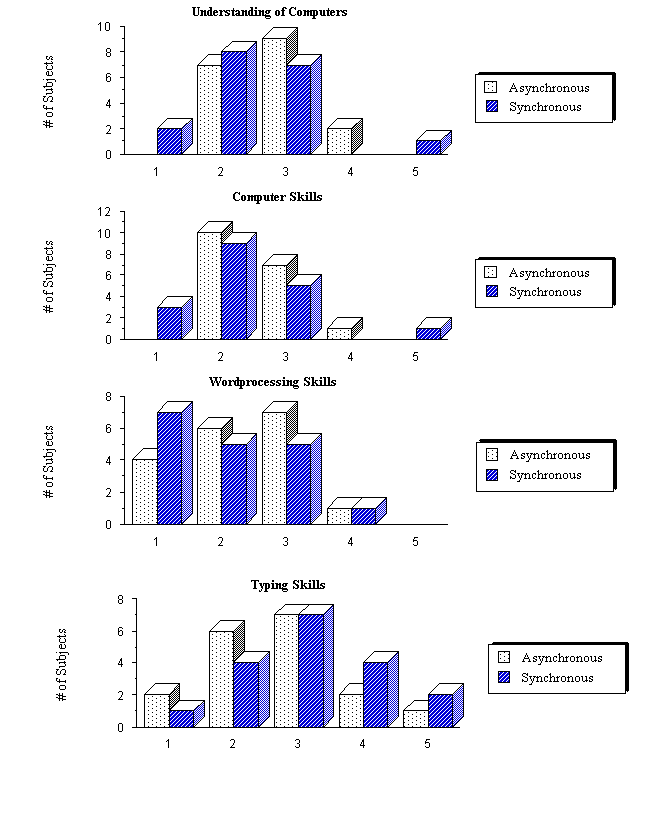
Figure 4-6: Use of Typewriter and Wordprocessor
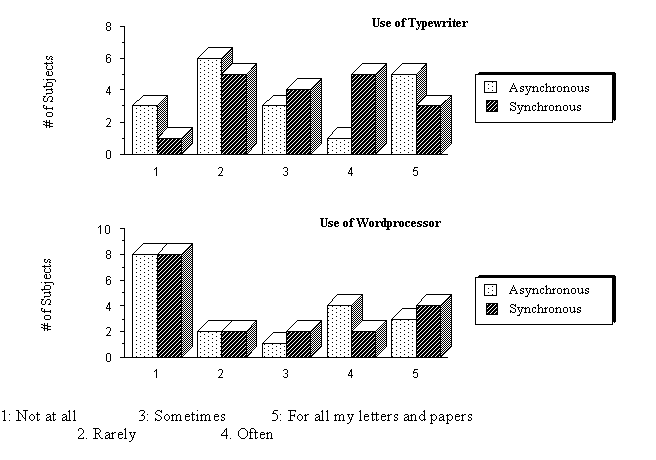
The characteristics of the sample as revealed in these data confirm the projected homogeneity of the groups in terms of their backgrounds and familiarity with computers. Also, their active participation and interaction during the sessions was an encouraging outcome.
Potential problems (in terms of gathering appropriate data for this study) such as inadequate time allowed for completion of the task, total lack of comprehension on the part of some subjects concerning the use of the computer for text-based interaction, or excessive, off-task, "chatty" behaviour did not arise in any significant way.




